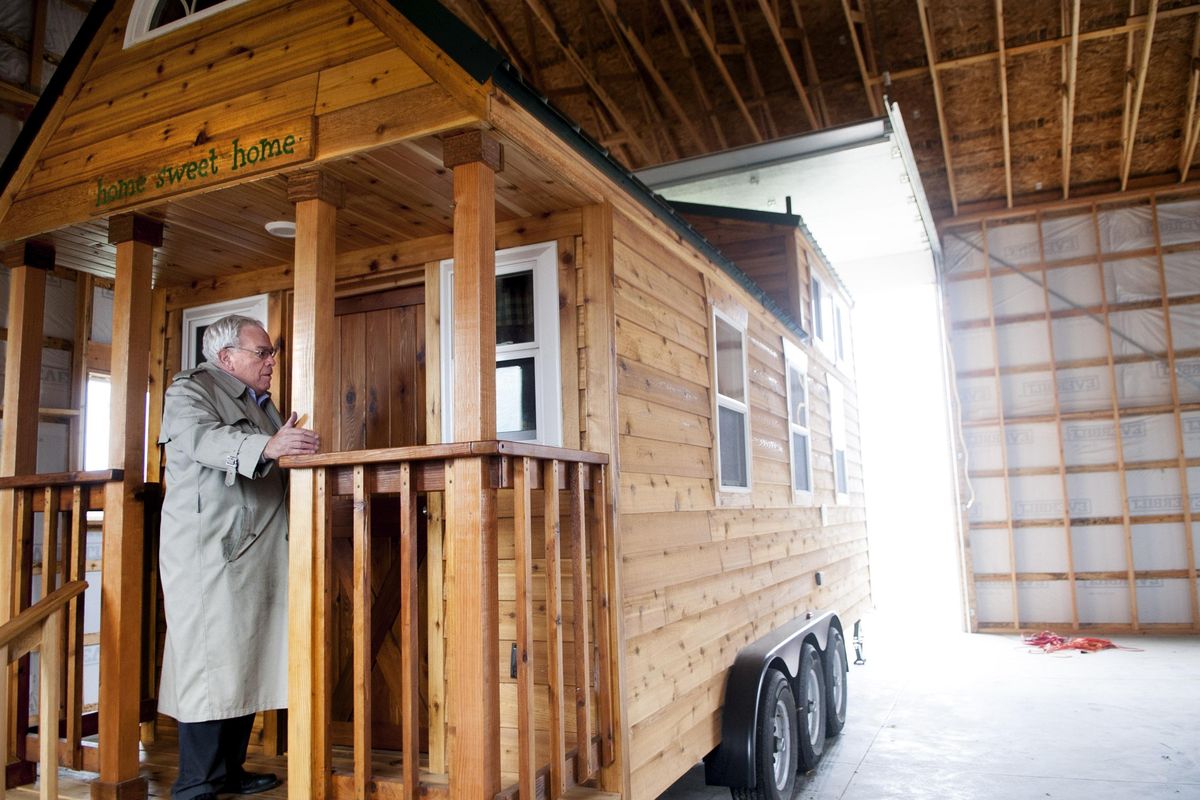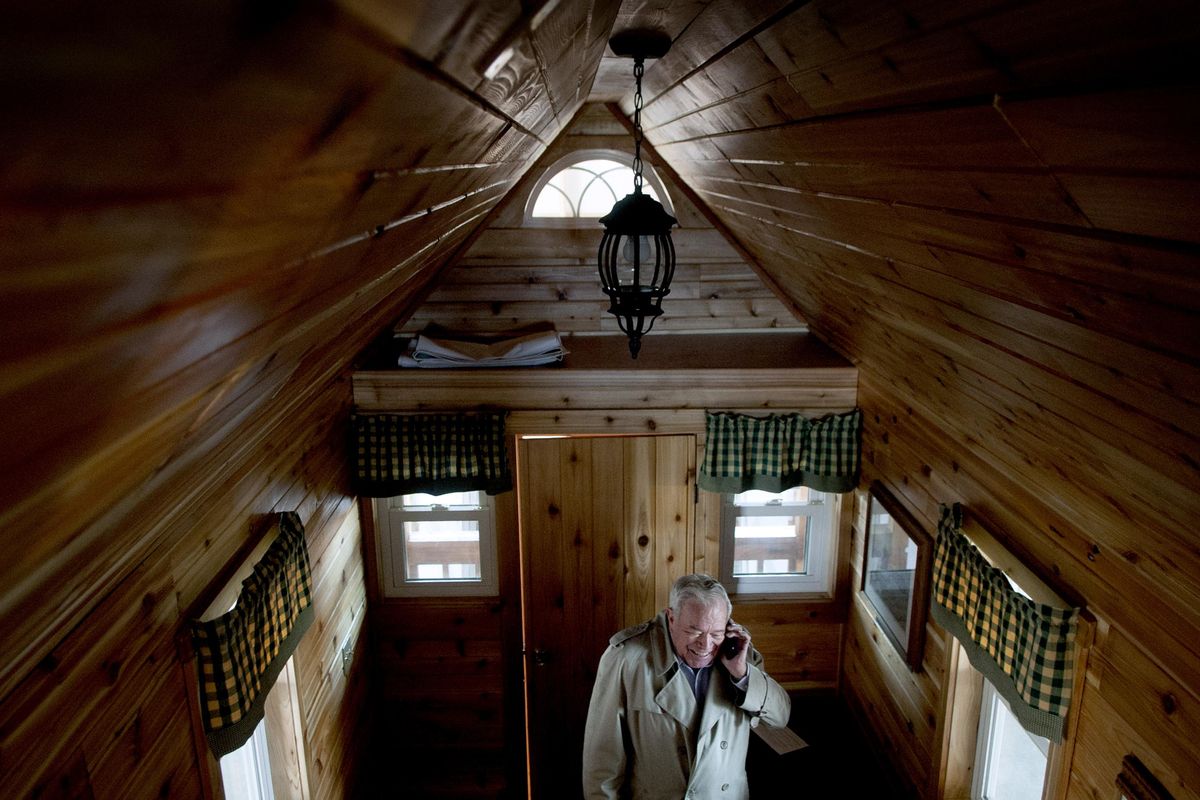This column reflects the opinion of the writer. Learn about the differences between a news story and an opinion column.
Doug Clark: Tiny houses hold big promise for homelessness
Ian Robertson talks about one of his tiny houses in Otis Orchards on Thursday, December 4, 2015. He’s created The Inland Northwest Fuller Center for Housing, a nonprofit program to have these tiny houses built for homeless people and people in need. (Kathy Plonka / The Spokesman-Review)Buy a print of this photo
It’s a beautifully constructed, two-story wood home on wheels, just 24 feet long and a little over 8 feet wide.
This is not an RV or a travel trailer. Proponents of the less-is-more living movement call dwellings like these “tiny houses” with good reason.
This one – with its green metal roof and a front porch with “Home Sweet Home” painted in green above the door – looks more like a quaint cabin in the woods.
Step inside. All the basic accouterments you’d expect to find in much bigger quarters are contained within the scant 326 square feet of living space.
The surprising thing is that it doesn’t feel cramped.
There’s a kitchen area with a stove. The loft is big enough for a queen-size mattress. The downstairs sleeping area contains a double bed.
A short walk (well, everything in here is a short walk) takes you to the bathroom in back where the necessary shower and porcelain throne await.
Robertson laughed.
Once you build the first one you tend to find ways to improve the product, he told me, “like adding a little more knee room for the toilet.”
I sat down on the closed lid. The man’s right. The wall in front of me is a tad close for true commode comfort.
If Robertson’s name sounds familiar, you may remember him as the affable Scotsman who joined me on election night last month.
The 78-year-old retired pastor grew up near Stirling, Scotland, and migrated to the United States when he was 21.
As I discovered on ballot night, however, my willing accomplice was greeted enthusiastically at both partisan political parties.
That’s because he serves on two of Mayor David Condon’s committees and has worked with Council President Ben Stuckart on other social causes.
The Greater Spokane Valley Chamber of Commerce gave Robertson a Citizen of the Year award in 2008. I’m definitely not used to hanging around people so respectable.
But when Robertson told me about the tiny house nonprofit project he’d started, well, I knew I’d be seeing him again.
In short, the Spokane Valley resident has come up with an ingenious way to supply housing and basic skills to people who are serious about wanting to change their lives.
The idea to do something, he said, came to him several years ago when he found homeless people camped out in his parking spot at Spokane’s Central United Methodist Church.
The numbers are staggering. According to Robertson, some 1,600 homeless children were registered last year with four Spokane County school districts.
“The average homeless family is a single mom with two children, one of them who’s under 6,” he added. “We need to do something better.”
Robertson has teamed with the Georgia-based Fuller Center for Housing. The nondenominational Christian organization was established by Habitat for Humanity founder Millard Fuller.
The Fuller Center forms partnerships with those who agree to build or provide affordable housing to those in need.
Building tiny houses struck Robertson as a way to give people a fresh start away from the urban core. “You can’t solve the problem in an environment of drug addicts and gangs,” he explained.
The plan, which Robertson calls his “passport to success and significance,” is to establish “tiny home villages” on land that has already been donated to the cause.
Check out www.fullercenter.org for more details or call (509) 922-5555.
After a screening process, people will be able to lease the homes while being taught the basics like managing finances, getting a job and even how to obtain a Social Security card.
All the lease money will be applied to a home’s purchase price, meaning a person “could own a home mortgage-free in five to seven years.”
But this is not only about shelter, Robertson added. This is about “building better people.”
Those who get involved will also be able to take part in building tiny homes, learning construction skills that can lead to future jobs.
If you’re wondering, Robertson plans to start production in January with an annual goal of 144 tiny homes.
It’s impressive how much preparation Robertson has put into such a complex and multilayered idea.
This man hasn’t spent all of his life behind a pulpit. Robertson’s employment history includes working for the Lockheed Missiles and Space Co. as a manufacturing training coordinator and engineering instructor.
So how does working on the Trident missile program translate to tiny homes?
“You don’t launch a rocket,” he said, “until all the sub-systems are ready.”
Perhaps the best news of all is that Robertson intends to fund his dream through private, not public money. And a good chunk of the startup money, it seems, has come from Robertson himself.
“I can’t tell you how much because my son takes the paper,” Robertson said, laughing again. “But I know we can make a difference.”
Doug Clark is a columnist for The Spokesman-Review. He can be reached at (509) 459-5432 or by email at dougc@spokesman.com.


